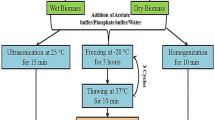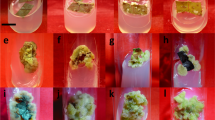Abstract
Synthesis of anthraquinones (AQs) involves the shikimate and 2-C-methyl-D-erythritol 4-phosphate pathways. The proline cycle is linked to the pentose phosphate pathway (PPP) to generate NADPH needed in the first steps of this pathway. The effect of two proline analogs, azetidine-2-carboxylic acid (A2C) and thiazolidine-4-carboxylic acid (T4C), were evaluated in Morinda citrifolia suspension cultures. Both analogs gave higher proline accumulation after 6 and 10 days (68 and 179% after 6 days with A2C at 25 and 50 μM, respectively, and 111% with T4C added at 100 μM). Induction of the proline cycle increased the AQ content after 6 days (~40% for 50 μM A2C and 100 μM T4C). Whereas A2C (50 μM) increased only AQ production, T4C also enhanced total phenolics. However, no induction of the PPP was observed with any of the treatments. This pathway therefore does not limit the supply of carbon skeletons to secondary metabolic pathways.




Similar content being viewed by others
References
Armero J, Requejo R, Jorrín J, López-Valbuena R, Tena M (2001) Release of phytoalexins and related isoflavonoids from intact chickpea seedlings elicited with reduced glutathione at root level. Plant Physiol Biochem 39(3):785–795. doi:10.1016/S0981-9428(01)01299-2
Bates LS, Waldren RP, Teare ID (1973) Rapid determination of free proline for water-stress studies. Plant Soil 39(1):205–207. doi:10.1007/BF00018060
Di Rienzo JA, Casanoves F, Balzarini MG, Gonzalez L, Tablada M, Robledo CW (2010) InfoStat versión 2010. Grupo InfoStat. FCA, Universidad Nacional de Córdoba, Argentina
Han YS, Van der Heijden R, Verpoorte R (2001) Biosynthesis of anthraquinones in cell cultures of the Rubiaceae. Plant Cell Tiss Organ Cult 67(3):201–220. doi:10.1023/A:1012758922713
Moreno PRH, van der Heijden R, Verpoorte R (1994) Elicitor-mediated induction of isochorismate synthase and accumulation of 2,3-dihydroxy benzoic acid in Catharanthus roseus cell suspension and shoot cultures. Plant Cell Rep 14(2–3):188–191. doi:10.1007/BF00233788
Perassolo M, Quevedo CV, Giulietti AM, Rodríguez Talou J (2011) Stimulation of the proline cycle and anthraquinone accumulation in Rubia tinctorum cell suspension cultures in the presence of glutamate and two proline analogs. Plant Cell Tiss Organ Cult 106:153–159. doi:10.1007/s11240-010-9903-5
Quevedo C, Perassolo M, Alechine E, Corach D, Giulietti AM, Talou JR (2010) Increasing anthraquinone production by overexpression of 1-deoxy-D-xylulose-5-phosphate synthase in transgenic cell suspension cultures of Morinda citrifolia. Biotechnol Lett 32:997–1003. doi:10.1007/s10529-010-0250-8
Rao SR, Ravishankar GA (2002) Plant cell cultures: chemical factories of secondary metabolites. Biotechnol Adv 20(2):101–153. doi:S0734975002000071
Schulte U, El-Shagi H, Zenk MH (1984) Optimization of 19 Rubiaceae species in cell culture for the production of anthraquinones. Plant Cell Rep 3(2):51–54. doi:10.1007/BF00270970
Shetty K (2004) Role of proline-linked pentose phosphate pathway in biosynthesis of plant phenolics for functional food and environmental applications: a review. Proc Biochem 39:789–803
Shetty P, Atallah MT, Shetty K (2003) Stimulation of total phenolics, L-DOPA and antioxidant activity through proline-linked pentose phosphate pathway in response to proline and its analogue in germinating fava beans (Vicia faba). Proc Biochem 38(12):1707–1717. doi:10.1016/S0032-9592(02)00257-1
Tarmizi AH, Marziah M (2000) Studies towards understanding proline accumulation in oil plam (Elaeis guineensis Jacq.) polyembryogenic cultures. J Oil Palm Res 12(1):8–13
Vasconsuelo A, Giulietti AM, Picotto G, Rodríguez Talou J, Boland R (2003) Involvement of the PLC/PKC pathway in Chitosan-induced anthraquinone production by Rubia tinctorum L. Cell cultures Plant Sci 165(2):429–436. doi:10.1016/S0168-9452(03)00208-5
Verpoorte R, Memelink J (2002) Engineering secondary metabolite production in plants. Curr Opin Biotechnol 13(2):181–187. doi:S0958166902003087
Yang R, Shetty K (1998) Stimulation of rosmarinic acid in shoot cultures of oregano (Origanum vulgare) clonal line in response to proline, proline analogue, and proline precursors. J Agric Food Chem 46:2888–2893
Acknowledgments
This work was supported by grant PICT 14-15112 and 14-33166, ANPCyT (Agencia Nacional de Promoción Científica y Tecnológica), Argentina, and by grant UBACyT B111, Universidad de Buenos Aires. R.T.J. and G.A.M. are researchers from CONICET (Consejo Nacional de Investigaciones Científicas y Técnicas), Argentina. Q.C.V and. P.M. are fellows from CONICET.
Author information
Authors and Affiliations
Corresponding author
Rights and permissions
About this article
Cite this article
Quevedo, C.V., Perassolo, M., Giulietti, A.M. et al. Enhancement of anthraquinone production in Morinda citrifolia cell suspension cultures after stimulation of the proline cycle with two proline analogs. Biotechnol Lett 34, 571–575 (2012). https://doi.org/10.1007/s10529-011-0806-2
Received:
Accepted:
Published:
Issue Date:
DOI: https://doi.org/10.1007/s10529-011-0806-2




